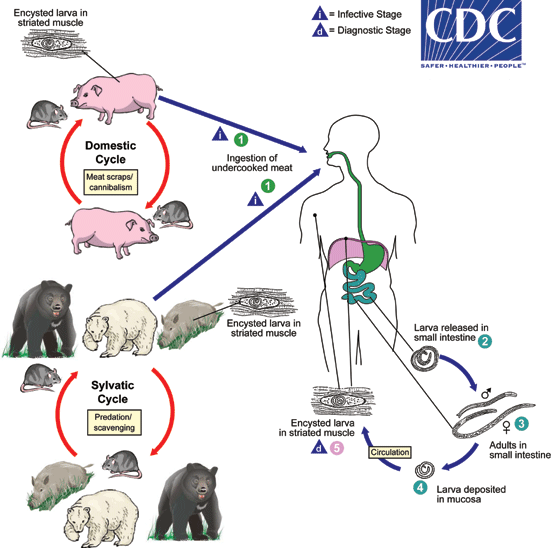Trichinosis causes
Jump to navigation
Jump to search
|
Trichinosis Microchapters |
|
Diagnosis |
|---|
|
Treatment |
|
Case Studies |
|
Trichinosis causes On the Web |
|
American Roentgen Ray Society Images of Trichinosis causes |
Editor-In-Chief: C. Michael Gibson, M.S., M.D. [1] Associate Editor(s)-in-Chief: Danitza Lukac
Overview
Trichinosis is caused by Trichinella species. The most common species involved in trichinosis is T. spiralis. Less common species include T. britovi, T. nativa, T. pseudospiralis, T. papuae, T. nelsoni, T. murrelli, and T. zimbabwensis.[1]
Causes
- Trichinosis is usually caused by T. spiralis. T. spiralis is usually found worldwide in many carnivorous and omnivorous animals,
- Other species of Trichinella include:[1]
- T. pseudospiralis (mammals and birds worldwide)
- T. nativa (Arctic bears)
- T. nelsoni (African predators and scavengers)
- T. britovi (carnivores of Europe and western Asia)
- T. papuae (wild and domestic pigs, Papua New Guinea and Thailand).
Species and characteristics:
| Disease | Main Source | Geographical Distribution |
|---|---|---|
| T. spiralis | Swine | Cosmopolitan |
| T. britovi | Wild boar, domesticated pigs | Europe, Asia, northern and western Africa |
| T. nativa | Polar bears, Artic foxes, walruses | Arctic, subarctic regions |
| T. papuae | Wild pigs, saltwater crocodiles | Papua New Guinea, Thailand |
| T. nelsoni | Warthogs, bush pigs | Eastern Africa |
| T. murrelli | Black bear | North America |
| T. zimbabwensis | Nile crocodiles, monitor lizards | Zimbabwe, Mozambique, Ethiopia, South Africa |
Life Cycle

- Trichinosis is acquired by ingesting meat containing cysts (encysted larvae) (life cycle stage: 1) of Trichinella.
- Sylvatic cycle: Pigs become infected when they eat infectious cysts in raw meat, often pork or rats.
- Domestic cycle: Humans become infected when they eat raw or undercooked infected pork.
- After exposure to gastric acid and pepsin, the larvae are released (life cycle stage: 2) from the cysts and invade the small bowel mucosa where they develop into adult worms (life cycle stage: 3) (female 2.2 mm in length, males 1.2 mm; life span in the small bowel: 4 weeks).
- After 1 week, the females release larvae (life cycle stage: 4) that migrate to the striated muscles where they encyst (life cycle stage: 5).
- Encystment is completed in 4 to 5 weeks and the encysted larvae may remain viable for several years.
- Ingestion of the encysted larvae perpetuates the cycle.
- Rats and rodents are primarily responsible for maintaining the endemicity of this infection.
- Carnivorous/omnivorous animals, such as pigs or bears, feed on infected rodents or meat from other animals.
- Different animal hosts are implicated in the life cycle of the different species of Trichinella.
- Humans are accidentally infected when eating improperly processed meat of these carnivorous animals (or eating food contaminated with such meat).[1][3]
References
- ↑ 1.0 1.1 1.2 1.3 Trichinosis. Wikipedia. https://en.wikipedia.org/wiki/Trichinosis. Accessed on January 22, 2016
- ↑ Gottstein B, Pozio E, Nöckler K (2009). "Epidemiology, diagnosis, treatment, and control of trichinellosis". Clin Microbiol Rev. 22 (1): 127–45, Table of Contents. doi:10.1128/CMR.00026-08. PMC 2620635. PMID 19136437.
- ↑ Trichinellosis. CDC. http://www.cdc.gov/parasites/trichinellosis/biology.html. Accessed on January 26, 2016